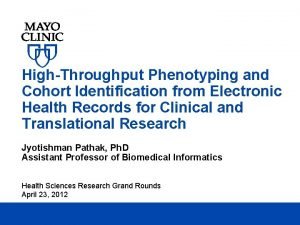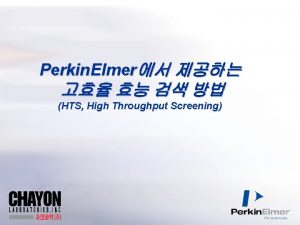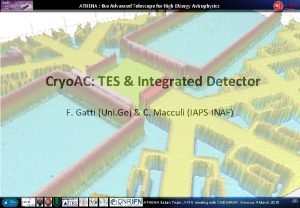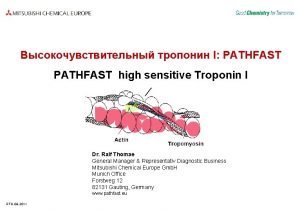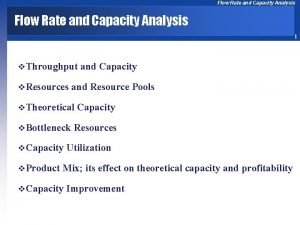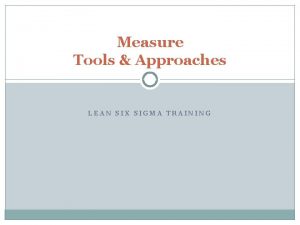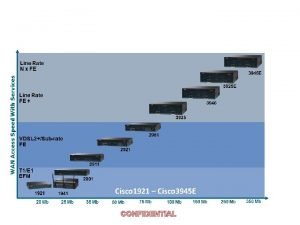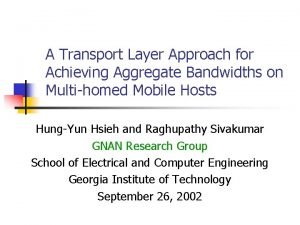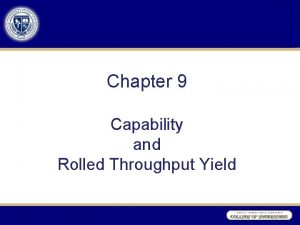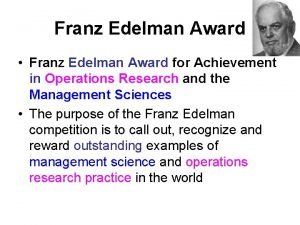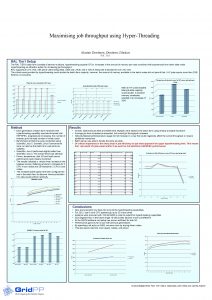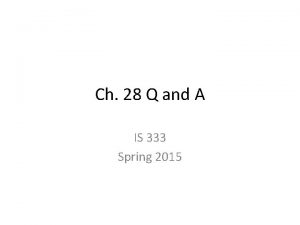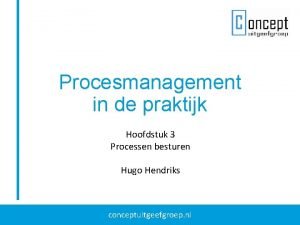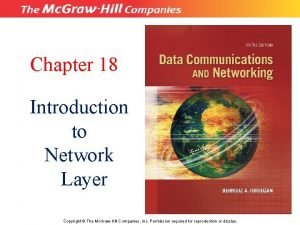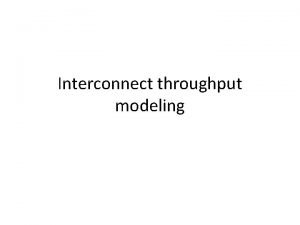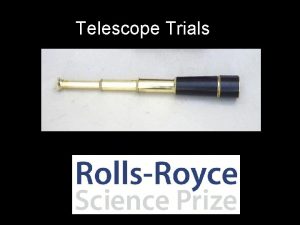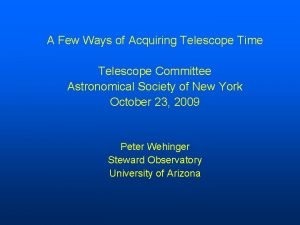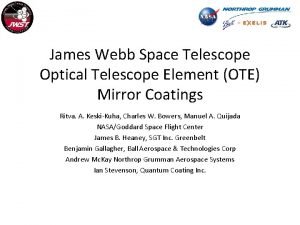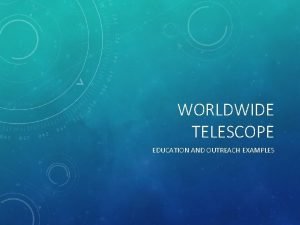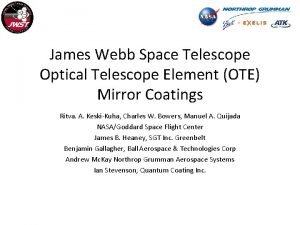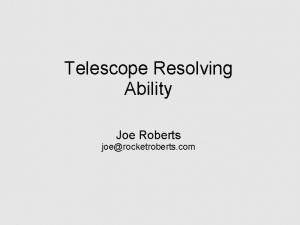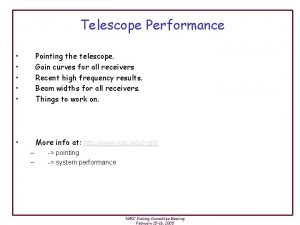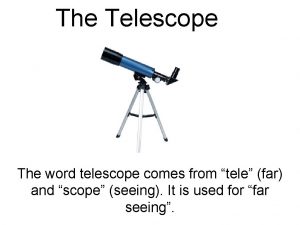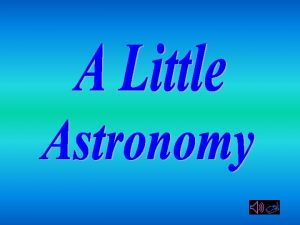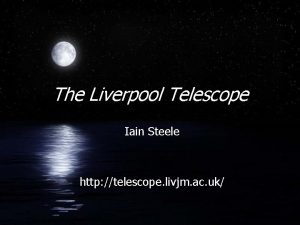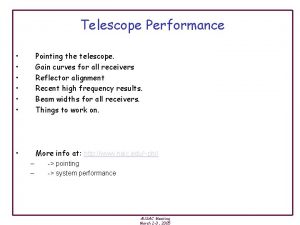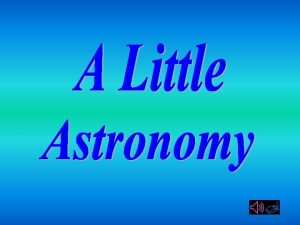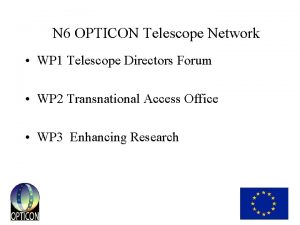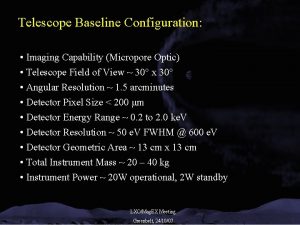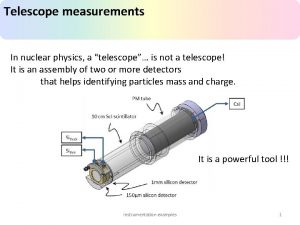CCATp a high throughput high sensitivity telescope for



















![Eo. R-IM: Intensity Mapping of [CII] in the Epoch of Reionization • Aggregate [CII] Eo. R-IM: Intensity Mapping of [CII] in the Epoch of Reionization • Aggregate [CII]](https://slidetodoc.com/presentation_image/9092e67bd18a289392c048099d8d0b12/image-20.jpg)
![Intensity Mapping of [CII] from the EOR • Measure large scale spatial fluctuations of Intensity Mapping of [CII] from the EOR • Measure large scale spatial fluctuations of](https://slidetodoc.com/presentation_image/9092e67bd18a289392c048099d8d0b12/image-21.jpg)
![Prediction of the [CII] Signal Strength Gong et al 2012 Noise requirement = 8 Prediction of the [CII] Signal Strength Gong et al 2012 Noise requirement = 8](https://slidetodoc.com/presentation_image/9092e67bd18a289392c048099d8d0b12/image-22.jpg)








- Slides: 30

CCAT-p: a high throughput, high sensitivity telescope for star and galaxy formation and cosmology Gordon Stacey Cornell University Representing the CCAT consortium 3 August 2017 US Radio/mm/submm Science Futures IIII 1

Who is CCAT-p? • Cornell University • German consortium led by University of Cologne – Cologne, Bonn, Ludwig Maximilian, Max Planck Inst. for Astrophysics v Formed CCAT Observatory, Inc. • Canadian consortium led by University of Waterloo – Waterloo, Toronto, British Columbia, Calgary, Dalhousie, Mc. Gill, Mc. Master, Western Ontario v Formed Canadian Atacama Telescope Corp (CATC) v CCAT is a Joint Venture between CCAT Corp & CATC 3 August 2017 US Radio/mm/submm Science Futures IIII 2

What is CCAT-p? CCAT-Prime is a high surface accuracy 6 m submm telescope 3 August 2017 US Radio/mm/submm Science Futures IIII 3

Where is CCAT-p? Cerro Chajnantor at 5600 m 3 August 2017 US Radio/mm/submm Science Futures IIII 4

Inspiration • Unique site enables unique science • High accuracy (< 11 m rms), low blockage telescope (< 1%) maximizes surface brightness sensitivity • Extraordinary throughput optimizes for science enabled by large scale surveys • CCAT-p paves the way, lowering risk for a large (25 meter) aperture at the same site 3 August 2017 US Radio/mm/submm Science Futures IIII 5

5000 meter is good, but 5600 meters is better • Submillimeter sensitivity is all about telluric transmission • Simon Radford ran tipping radiometers at primary sites for more than a decade – • Simultaneous period for CCAT vs. ALMA site: median is 0. 6 vs. 1 mm H 2 O factor of 1. 7 in sensitivity 3 August 2017 Radford & Peterson, ar. Xiv: 1602. 08795 US Radio/mm/submm Science Futures IIII 6

Median Zenith Transmission Median CCAT transmission even better than South Pole due to warmer, less dense atmosphere Tropics: Ω = 3 π sr, Amed = 1. 1 (z < 60°) 3 August 2017 US Radio/mm/submm Science Futures IIII Pole: Ω = 1 π sr, Amed = 1. 4 (z < 60°) 7

Chajnantor Site opens up the THz Windows 3 August 2017 US Radio/mm/submm Science Futures IIII 8

Crossed Dragone Design • Original concept published AT&T Tech. 0. 9 diameter optics tubes in 3 1978: mm = C. 37 Dragone OT 26, 000 pixels. Mem. 57, 2663 are mostly enclosed 2 mm = 33 OT 58, 000 pixels • Used in 2 <2 m CMB experiments (QUIET, C. Bischoff. et al. 2013) 1 mm. T. = Essingger-Hileman 19 OT 110, 000 pixels and in the. Strehl>0. 8 Atacama B-Mode Search, et al. 2009 (diffraction-limited) 0. 35 mm = 7 OT 400, 000 pixels Optics tube 7. 8 Fo. V M. Niemack, Applied Optics 2016 3 August 2017 US Radio/mm/submm Science Futures IIII

CCAT-prime CCATprime Shutter 5 4 meter instrument space Mirrors M 1 & M 2 Elevation Housing Yoke Structure Being Cone designed and built by Vertex Antennentechnik Gmb. H Support 3 August 2017 US Radio/mm/submm Science Futures IIII 10

P-Cam • • Seven subcamera “tubes” populated with TES bolometers Currently looking at a system with 13 optics tubes that Fo. V ~ 0. 9 degree with feedhorn fed 1. 5 /D pixels enables our first light science to be completed in < 5 years – 20, 000 (first light) to 60, 000 (fully populated) pixels per subcamera @ 350 m; – For other wavelengths, numbers scale from 60, 000 as 1/ 2 Cryogenics rearranged so that optics tubes can be – dichroic polarization sensitive bolometers at longer wavelengths added/exchanged on the telescope from the back Cameras are modular (size, optics, filtration), easily exchanged Start with very modest numbers of pixels and growth to fill out camera, then entire CCAT-Prime Fo. V if so desired 3 August 2017 US Radio/mm/submm Science Futures IIII 11

CCAT-Prime Science • GEco: Star formation in the Milky Way, the Magellanic clouds and other nearby galaxies through submm spectroscopy and photometry • k. SZ: Probing of the nature of dark energy, gravity on large scales and neutrino mass sum through kinetic SZ effect – Polarization foregrounds: Galactic dust science & CMB poln corrections • GEvo: Evolution of DSFG through submm-mm wave surveys. • IM-Eo. R: Eo. R intensity mapping in [CII] at redshifts from 5 to 9. • Stage 4 CMB: CMBR polarization at 10 times the speed of current facilities inflationary gravity waves and the sum of the neutrino masses. 3 August 2017 US Radio/mm/submm Science Futures IIII 12

GEco: Galactic Ecology Science • 15” imaging over 200 ( )2 scales of the Milky Way, LMC, SMC in: – [CI] tracing gas temperature and mass – Mid and high-J CO & 13 CO tracing gas excitation, shocks, density and mass – Also: [NII] tracing embedded SF regions and numbers of ionizing photons • Tracing accumulation and flows of gas into cores and young stars • Requires high site for short submm (200 m, or 1. 5 THz) studies 3 August 2017 US Radio/mm/submm Science Futures IIII 13

“CO dark” Gas 3 August 2017 US Radio/mm/submm Science Futures IIII 14

k. SZ: Cluster Science through the Sunyaev-Zel’dovich Effects Direct observations of the most massive bound entities in the Universe through Sunyaev. Zel’dovich effects • 7 colors: 0. 35 to 3 mm spectral coverage separates out the t. SZ, radio galaxies and submm galaxies from k. SZ • Constraints: optical depth, velocity, and electron temperature 3 August 2017 US Radio/mm/submm Science Futures IIII 15

Fundamental Physics Probes Directly measure velocities of 1000’s of clusters • Constrains and/or eliminate models about dark energy and modified gravity. • Improve constraints on the measurements of the sum of the neutrino masses. • Cluster characterization to inform cosmology • Example Survey 1000 ( )2 measuring 3000 clusters with M > 2. 7 1014 M in 3000 hrs 3 August 2017 CCAT-prime velocities appear much better than Advanced ACTPol F. de Bernardis and A. Mittal US Radio/mm/submm Science Futures IIII 16

Obscured SF over Cosmic Time • CCAT-p aperture lowers 3. 5 m Herschel confusion limits • Herschel surveys limited to ~ 6. 3 m. Jy (1 ) confusion limit • 5. 5 m CCAT-p goes a factor of ~ 2. 6 deeper into the confusion P-Cam 350 um pixel P-Cam Subcamera Fo. V = 0. 9 – 2. 4 m. Jy (1 ) in 3 hrs @350 m • One camera, using best 50% weather 100( )2 (or 300 ( )2 for full camera) survey @ 350 m) per year • Pushes down the luminosity function in the most active epoch star formation in the Universe 3 August 2017 Her. MES Lockman Hole North; Oliver et al. (2010, 2011) US Radio/mm/submm Science Futures IIII 17

CCAT-prime and Herschel Courtesy of B. Magnelli 3 August 2017 US Radio/mm/submm Science Futures IIII 18

CCAT-p Explores FIR Luminosity Function Rare beasts A 2 M L A r o erschel 2 than H r e p e e D Courtesy of B. Magnelli 3 August 2017 US Radio/mm/submm Science Futures IIII 19
![Eo RIM Intensity Mapping of CII in the Epoch of Reionization Aggregate CII Eo. R-IM: Intensity Mapping of [CII] in the Epoch of Reionization • Aggregate [CII]](https://slidetodoc.com/presentation_image/9092e67bd18a289392c048099d8d0b12/image-20.jpg)
Eo. R-IM: Intensity Mapping of [CII] in the Epoch of Reionization • Aggregate [CII] signal from star forming galaxies at z ~ 5 to 9 3 -D information: – Reveals the process of reionization and the underlying dark matter distribution over the cosmic time when the first galaxies formed • Combine with SKA 21 cm HI line tracing neutral ISM concentrations 3 August 2017 US Radio/mm/submm Science Futures IIII 20
![Intensity Mapping of CII from the EOR Measure large scale spatial fluctuations of Intensity Mapping of [CII] from the EOR • Measure large scale spatial fluctuations of](https://slidetodoc.com/presentation_image/9092e67bd18a289392c048099d8d0b12/image-21.jpg)
Intensity Mapping of [CII] from the EOR • Measure large scale spatial fluctuations of collective aggregate of faint galaxies via redshifted [CII] 158 m line (and possibly other lines at other redshifts) – Resolution into individual galaxies not required • Clustering scale 0. 5 to 1 Mpc or ~1 -2’ at z = 5 -9, - good match for 6 -m aperture (40”@ 1 mm) • 16 2 surveys: spectral/spatial mapping speed critical • Single camera tube Fo. V ~ 1 matches 40 Mpc void size-scale: systematics • Need moderate spectral resolution R ~ 300 -500 – Bandwidth z ~ 5 -9 signal is 0. 95 -1. 6 mm (190 -315 GHz) • Identify lower z CO emitters by line multiplicity • Sensitivity is at a premium: high site, very low emissivity telescope is essential! 3 August 2017 US Radio/mm/submm Science Futures IIII 21
![Prediction of the CII Signal Strength Gong et al 2012 Noise requirement 8 Prediction of the [CII] Signal Strength Gong et al 2012 Noise requirement = 8](https://slidetodoc.com/presentation_image/9092e67bd18a289392c048099d8d0b12/image-22.jpg)
Prediction of the [CII] Signal Strength Gong et al 2012 Noise requirement = 8 10 -14 W/m 2/sr 3 August 2017 US Radio/mm/submm Science Futures IIII RP = 500 22

Large BW Fo. V Spectrometer • Trans-mm wave from ~ 0. 95 to 1. 6 mm (315 -188 GHz) • Direct detection for optimal sensitivity • Resolving power requirement is modest, ~ 500 or 600 km/sec • Need a spectral spatial product > 20, 000 to complete a 16 2 survey in 4000 hours. • Spectrometer extremes: – 312 spectral positions, 64 spatial positions w/ grating – 1 spectral sample, 20, 000 spatial positions w/ FPI 3 August 2017 US Radio/mm/submm Science Futures IIII 23

Eo. R IM Science Program • The spectral multiplexer (e. g. transmission line resonant spectrometer) is challenging at present • The spatial multiplexer is very straight-forward • Requirement: Eo. R IM 16( )2 survey in 4000 hours Need only 10 to 20% the number Predictions: 90” beams with top 2 quartiles of weather: of pixels of grating because we Using 1. 8 cameras with dichroic pixels tuned to 1. 1 and accepted 4 spatial modes 1. 4 mm wavelength, we can survey a 16( )2 field to the required a 1 noise limit of 8 10 -14 W/m 2/sr in 4000 hours integration time Total number of pixels: 1. 8 1050 (dichroic) or 3. 6 1050 single color using top 2 weather quartiles 3 August 2017 US Radio/mm/submm Science Futures IIII 24

A Tough Experiment! • The zenith transmission is: – 97. 1 to 92. 5% (1 st to 3 rd quartile) at CCAT-p site – 95. 7 and 89. 5% (1 st to 3 rd quartile) at ALMA site • Telescope emissivity is < 2% Reduce sky emissivity by factor of 1. 5 – Going makes a difference! Needoff-axis to maximize sensitivity which means • Predicted total system emissivity is ~ 6. 6% minimizing emissivity – Window emissivity makes a difference (2%)! – Going to 5600 m makes a difference! • Would need 1. 5 times as many optics tubes at ALMA site • Spectrometer transmission is 40% including DQE of 80% Note that the same stringent requirements hold for the grating spectrometer 3 August 2017 US Radio/mm/submm Science Futures IIII 25

Fabry-Perots in Development R = 106 FPI at 112 um for HIRMES on SOFIA • These are based on free-standing metal mesh • Developing silicon substrate-based FPI: • Silicon AR coatings (dual layer) with microstructures • Metalized (superconducting) broad-band reflectors • US Radio/mm/submm Science 3 August 2017 Futures IIII 26

Comparisons to other Coeval Facilities • Eo. R IM: surface brightness: WFE, emissivity, site, and Fo. V: – Sensitivity (Jy/beam) • 1/Ruze Efficiency • ~ (System Emissivity)1/2 – telescope, warm optics and sky • 1/(warm transmission) – includes telescope efficiency, sky transparency – Mapping Speed “intrinsic” P-Cam Fo. V • (Sensitivity referred to EOR beam)2 “clipped” Fo. V • Field of view accepted/field of view of P-Cam subcamera Med. sky tel. PWV (245 GHz) emis. Teles. WFE (rms), Ruze eff. APEX 17 m, 97% 1. 0 0. 945 10% 0. 86 24. 8’ 11. 4’ 1/16 JCMT 25 m, 93% 2. 0 0. 901 10% 0. 93 19. 8’ 9. 0’ 1/28 LMT 70 m, 58% 2. 01 0. 901 15% 0. 51 5. 9’ 8. 0’ 1/77 CCAT-p 10. 5 m, 99% 0. 60 0. 962 2. 8% 1 54’ 1 This Raw Sens. 2 P-Cam Fo. V (dia. ) Mapping Speed 1 7 weather is only 4 months/year; 2 Refers to a 65” beam and source elevation of 50 3 August 2017 US Radio/mm/submm Science Futures IIII 27

Comparisons to other Coeval Facilities • k. SZ; GEvo: short submm bands: WFE, emissivity, site, and Fo. V: Point source foregrounds 1 st Q sky tel. PWV (860 GHz) GHz emis. Teles. WFE (rms), Ruze eff. APEX 17 m, 69% 0. 6 0. 25 10% 0. 54 24. 8’ 11. 4’ 1/1. 43 -1/5. 94 JCMT 25 m, 44% 1. 0 0. 12 10% 1. 31 19. 8’ 9. 0’ 1/8. 33 -1/564 LMT 50 m, 4% 1. 01 0. 12 15% 1. 47 5. 9’ 8. 0’ 1/8. 63 -1/6404 0. 39 2. 8% 1 54’ CCAT-p 10. 5 m, 87% 1 This Raw P-Cam Fo. V Sens. 2 Fo. V (dia. ) Mapping Speed 1 7 weather is only 4 months/yr; 2 Point source – el. = 50 ; 3 beams, 4 areal coverage 1’-scale k. SZ Science Med. sky tel. Raw P-Cam PWV (245 GHz) emis. Sens. 2 Fo. V Teles. WFE (rms), Ruze eff. APEX 17 m, 97% 1. 0 0. 945 10% 0. 86 JCMT 25 m, 93% 2. 0 0. 901 10% LMT 70 m, 58% 2. 01 0. 901 CCAT-p 10. 5 m, 99% 0. 60 0. 962 1 This 3 weather August 2017 is Fo. V (dia. ) Mapping Speed 24. 8’ 11. 4’ 1/16 0. 93 19. 8’ 9. 0’ 1/28 15% 0. 51 5. 9’ 8. 0’ 1/77 2. 8% 1 54’ US Radio/mm/submm Science 1 7 only 4 months/year; 2 Refers to IIII a 65” beam and source elevation of 50 Futures

Schedule Four (4) year project (July 2017 to June 2021) - 20 months Detailed Design [PDR @ 4 months; CDR @ 10 months, FDR @ 18 months. ] - 13 months Fabrication which includes a trial assembly in Germany - 3 months Shipping & Receiving - 12 months Assembly/Checkout §Including 3 months unpacking/inspection and sequenced transport to summit Project is started! – but still would welcome new partners 3 August 2017 US Radio/mm/submm Science Futures IIII 29

2016 CCAT. All Rights Reserved. www. ccatobservatory. org
 High throughput phenotyping
High throughput phenotyping Mass_947
Mass_947 High throughput satellite
High throughput satellite Perkin elmer high content screening
Perkin elmer high content screening Advanced telescope for high energy astrophysics
Advanced telescope for high energy astrophysics High definition space telescope
High definition space telescope Pathfast hsctni
Pathfast hsctni Throughput yield
Throughput yield Throughput formula
Throughput formula Throughput formula
Throughput formula Learner throughput rates
Learner throughput rates Throughput vs bandwidth
Throughput vs bandwidth Process capacity analysis
Process capacity analysis Patient throughput definition
Patient throughput definition Rolled throughput yield vs first pass yield
Rolled throughput yield vs first pass yield Cisco 1921 performance
Cisco 1921 performance Berkeley
Berkeley The throughput billing of cosmosdb is based on
The throughput billing of cosmosdb is based on Average throughput
Average throughput Throughput vs bandwidth
Throughput vs bandwidth Rv220w dual gigabit wan vpn router
Rv220w dual gigabit wan vpn router Throughput time formula
Throughput time formula Throughput yield formula
Throughput yield formula Pricing analysis for merrill lynch integrated choice
Pricing analysis for merrill lynch integrated choice Can far memory improve job throughput
Can far memory improve job throughput Throughput model pmo
Throughput model pmo Throughput vs goodput
Throughput vs goodput Sand cone model
Sand cone model Average throughput
Average throughput Bandwidth vs throughput
Bandwidth vs throughput Aggregate throughput
Aggregate throughput
